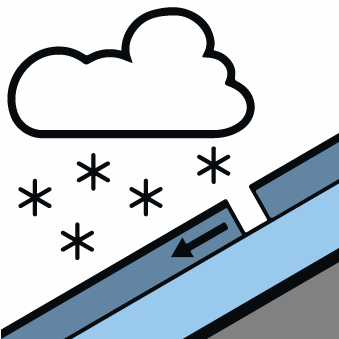
Danger level
 | treeline
|
Avalanche Problem
 | | New snow |
|  | |  |
 | | Wind-drifted snow |
|  | |  |

A dangerous avalanche situation will be encountered over a wide area.
More natural avalanches are to be expected. This applies in all aspects above the tree line, as well as in areas close to the tree line. Avalanches can be triggered in the faceted old snow and reach a dangerous size. Slides are to be expected on cut slopes.
As a consequence of the strong northerly wind, fresh snow drift accumulations will form, also at low and intermediate altitudes. These are in some cases quite large. Avalanches can in many places be released very easily and reach dangerously large size.
Naturally triggered avalanches and avalanches triggered by explosives confirm a dangerous avalanche situation. Great caution and restraint are important.
Snowpack
dp.5: snowfall after a long period of cold
dp.6: cold, loose snow and wind
Over a wide area 40 to 60 cm of snow, and even more in some localities, has fallen in all altitude zones. The wind has transported the new snow significantly. In some places new snow and wind slabs are lying on surface hoar. The old snowpack is faceted and has faceted crystals on the surface. The brittle wind slabs are lying on the unfavourable surface of an old snowpack.
Tendency
A dangerous avalanche situation will be encountered over a wide area.

Danger level
 | treeline
|
Avalanche Problem
 | | Wind-drifted snow |
|  | |  |
 | | Persistent weak layer |
|  | |  |

A dangerous avalanche situation will prevail. New snow and wind slabs represent the main danger.
The new snow and wind slabs are lying on the unfavourable surface of an old snowpack in all aspects, also in areas close to the tree line, as well as below the tree line. Avalanches can be triggered in the faceted old snow and reach large size in isolated cases. Natural avalanches are possible.
As a consequence of the sometimes strong wind the wind slabs will increase in size additionally as the day progresses. Avalanches can in many places be released very easily and reach large size in isolated cases. In the regions neighbouring those that are subject to danger level 4 (high) the avalanche danger is higher.
In addition a latent danger of gliding avalanches exists.
Backcountry touring calls for great caution and restraint.
Snowpack
dp.5: snowfall after a long period of cold
dp.8: surface hoar blanketed with snow
Over a wide area 10 to 30 cm of snow, and even more in some localities, has fallen, in particular in the north and in the northwest. In the southeast a little new snow. The sometimes storm force wind has transported the new snow and, in some cases, old snow as well. The brittle wind slabs are lying on unfavourable layers in all aspects. Over a wide area new snow and wind slabs are lying on surface hoar.
Precarious weak layers exist in the centre of the snowpack.
Tendency
The avalanche conditions are to some extent precarious. New snow and wind slabs are to be assessed with care and prudence.

Danger level
 | treeline
|
Avalanche Problem
 | | Wind-drifted snow |
|  | |  |
 | | Persistent weak layer |
|  | |  |

A dangerous avalanche situation will prevail. The new snow and wind slabs remain prone to triggering.
The new snow and wind slabs are prone to triggering in all aspects. This applies above the tree line, as well as in areas close to the tree line. As a consequence of the sometimes strong wind the wind slabs will increase in size additionally as the day progresses. Avalanches can in many places be released easily and reach medium size.
Additionally in isolated cases avalanches can be released in deep layers. Backcountry touring calls for great caution and restraint.
Snowpack
dp.6: cold, loose snow and wind
dp.8: surface hoar blanketed with snow
5 to 10 cm of snow has fallen since Wednesday. The strong wind has transported the fresh and old snow significantly. The brittle wind slabs are lying on unfavourable layers.
Isolated avalanche prone weak layers exist in the top section of the snowpack.
Tendency
Outside marked and open pistes a dangerous avalanche situation will prevail.













